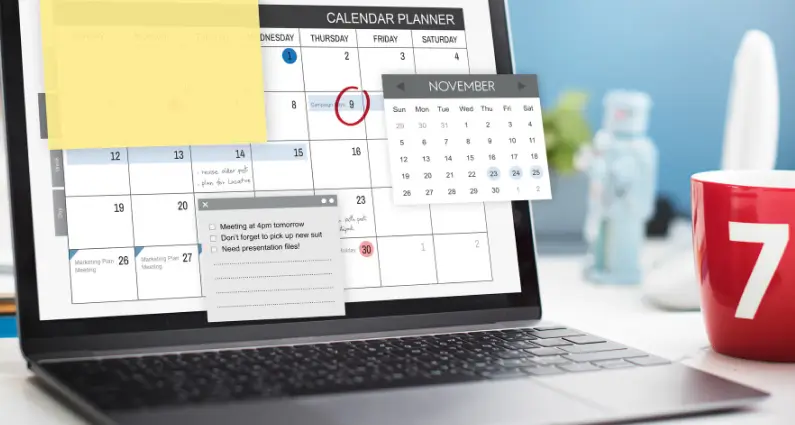
Managing multiple rental listings across different platforms can feel like juggling flaming torches. One wrong move can result in double bookings, which will make your guests angry and your reputation suffer.
Calendar synchronization, a powerful tool, can automate the headache of managing multiple rental listings across different platforms. It’s a game-changer that can prevent double bookings, keeping your guests happy and your reputation intact.
When someone books your property on Airbnb, those dates should automatically become unavailable on Booking.com and your WordPress site. That’s what calendar sync does – it keeps all your platforms talking to each other so you don’t have to update each one manually.
Understanding Calendar Synchronization Basics
Calendar sync works through something called iCalendar (or iCal for short). Consider it a universal language that booking platforms use to share availability information. Each platform can create an iCal feed (a special web address ending in .ics) that others can read.
Here’s how it works in practice:
- Airbnb creates a feed showing when your property is booked
- Your WordPress site reads that feed and blocks those exact dates
- Your WordPress site also creates its own feed
- Booking.com reads your WordPress feed and blocks those dates, too
The sync isn’t instant—most platforms check for updates every few hours—but it’s a huge relief from manually updating five different calendars every time you get a booking.
Preparing Your WpRentalsWordPress Site for Calendar Sync
Your WordPress site needs some basic setup before you start connecting external calendars. These steps might seem tedious, but they are crucial to prevent sync failures later. This is how you create a caledar sync page for WpRentals theme. For other software you need to check the their documentation,.
Create Your Calendar Feed Page
Your site needs a special page that generates the iCal feed. Go to Pages → Add New in your WordPress admin and create a blank page. Title it like “Calendar Feed” – the name doesn’t matter much since visitors won’t see it.
The important part is selecting the right template. Look for “ICAL FEED” in your page template dropdown and select it. If you don’t see this option, your theme might not support calendar sync (WPRentals and similar rental themes include this feature).
Get SSL Working
Your site must use HTTPS (you’ll see the lock icon in browsers). Calendar sync won’t work without it because external platforms refuse to connect to unsecured sites. The good news is that most hosting companies offer free SSL certificates these days, ensuring your site’s security.
Publish Your Listings
This sounds obvious, but draft or pending listings won’t sync. Every property you want to include in calendar sync must be published and live on your site.
Turn Off Maintenance Mode
Calendar sync stops working if you have a “coming soon” page or maintenance mode active. External platforms can’t reach your feeds if your site is in maintenance mode.
Add Initial Bookings
Here’s a weird quirk: some platforms (especially Booking.com) reject empty calendar feeds. Add at least one booking or blocked date to each property before setting up sync. You can use a dummy booking on a past date if needed.
Importing External Calendars Into WordPress
Getting bookings from Airbnb and Booking.com into your WordPress site prevents double bookings. Each external platform provides an iCal feed you can import.
Getting the Feed URL from Airbnb
To get the feed URL from Airbnb, log in to your host account and navigate to your listing’s calendar settings. Look for ‘Calendar sync’ or ‘Export Calendar’ under your listing’s availability section. Airbnb will display an iCal URL like: https://www.airbnb.com/calendar/ical/12345678.ics?s=abcdef123456. Copy this entire URL for use on your WordPress site.
Airbnb will show you an iCal URL that looks something like: https://www.airbnb.com/calendar/ical/12345678.ics?s=abcdef123456.
Copy this entire URL – you’ll need it for your WordPress site.
Getting the Feed URL from Booking.com
Your property’s calendar section is in the Booking.com Extranet. Look for “Sync calendars” or “Calendar connections.” Booking.com provides an export URL for each property.
The URL format varies, but always ends in .ics. Make sure you copy the complete link.
Adding External Feeds to WordPress
Once you have the external URLs, adding them to your WordPress site depends on your theme. In WPRentals (and similar themes), go to your front-end dashboard and edit the listing.
Find the Calendar tab for an “Import external iCal feed” section. You’ll see fields for:
- Feed Name (enter something like “Airbnb” or “Booking.com”)
- Feed URL (paste the .ics link you copied)
Click “Add New feed” and the system will immediately fetch the latest bookings. You can add multiple feeds per property – one for Airbnb, another for Booking.com, etc.
Verifying the Import Worked
Check your property’s calendar after adding external feeds. External bookings typically appear in a different color (often purple) with labels showing the source. An Airbnb booking might show as “Airbnb” while a Booking.com reservation displays as “Booking.com.”
Exporting Your WordPress Calendar to Other Platforms
Import only works one way – bringing external bookings into WordPress. You also need to export your WordPress bookings to other platforms.
Finding Your WordPress iCal URL
Your WordPress theme should generate a unique iCal feed for each property. In WPRentals, this appears in the listing’s Calendar tab as an iCal feed URL. Copy this link – it might look like: https://yoursite.com/ical-feed/?ical=property123.
Adding to Airbnb
In Airbnb’s calendar settings, look for “Import Calendar” or “Connect to another calendar.” Paste your WordPress iCal URL here and name it “Website Calendar.”
Airbnb updates imported calendars every 3 hours automatically. You can also manually refresh if needed.
Adding to Booking.com
Booking.com’s calendar sync section has an option to import external calendars. Add your WordPress iCal URL here with a descriptive name.
Double-Check the Connections
After setting up both import and export, you should have:
- External bookings flowing into WordPress
- WordPress bookings are flowing to external platforms
Test this by booking on one platform and checking if it appears elsewhere within a few hours.
Working Around Sync Limitations
Calendar sync isn’t perfect. Understanding its limitations helps you avoid problems.
Timing Delays
Updates aren’t instant. Most platforms check for changes every 3 hours, so new bookings can take that long to appear elsewhere. This creates a small window where double bookings are possible.
Consider setting a minimum advance notice (24 hours) during high-demand periods to give sync time to catch up.
Availability Only
iCal feeds only share whether dates are booked or available. They don’t include guest names, contact info, or prices. You’ll still manage booking details on the platform where the reservation was made.
One-Way Links
Each iCal feed works in one direction only. Importing Airbnb into WordPress doesn’t return WordPress bookings to Airbnb – you need separate export links.
Channel Manager Conflicts
Using a channel manager service (software that connects to multiple booking platforms via API) might disable iCal sync. Airbnb, for example, disables calendar imports for API-connected listings.
Don’t mix iCal sync with channel manager APIs for the same property. Choose one method and stick with it.
Improving Sync Reliability
Default sync timing might not suit your needs. Here are ways to make it work better:
Adjust Sync Frequency
WordPress checks external calendars on a schedule you can modify. Installing the WP Crontrol plugin lets you see and edit these scheduled tasks.
Look for a cron job related to calendar sync (it might be named something like “wpestate_sync_ical”) and change it from every 3 hours to hourly. Don’t go too frequently—checking every few minutes might overload your server or trigger rate limits.
Manual Refresh Options
Train your team to trigger syncs when needed manually. After booking a last-minute Airbnb, quickly log into WordPress and save the listing’s calendar settings. This forces an immediate fetch of all external feeds.
Monitor and Test Regularly
Set up a weekly check to verify sync is working. Make test bookings and confirm they appear on other platforms. Catch broken feeds before they cause double bookings.
Property Owner Education
If multiple people manage listings on your site, create simple instructions for finding iCal URLs on each platform. Many sync problems come from using the wrong links or forgetting to set up both import and export.
Consider requiring owners to provide their external platform iCal links during the listing submission process.
Technical Troubleshooting Tips
When sync stops working, these steps usually fix the problem:
Check SSL Certificate
Expired or broken SSL certificates break calendar sync immediately. Use SSL Checker to verify your certificate is valid.
Verify iCal Feed URLs
Test your WordPress iCal feeds by pasting them into a browser. You should see calendar data in .ics format, not an error page.
Clear Caching
If you use caching plugins, make sure they do not cache your iCal feed pages. Calendar feeds need to show real-time data.
Test External Links
Occasionally, platforms change their iCal URL formats. If sync stops working, get fresh export links from Airbnb or Booking.com and update them in WordPress.
Reliable calendar sync requires some initial setup, but once configured properly, it saves hours of manual work. The key is understanding that it’s not real-time, setting up import and export connections, and monitoring the system regularly.
When done right, you’ll wake up to find all your calendars perfectly synchronized without lifting a finger. Your guests will have accurate availability, embarrassing double bookings will be avoided, and you can focus on what really matters—providing great experiences instead of managing spreadsheets.






No comment yet, add your voice below!